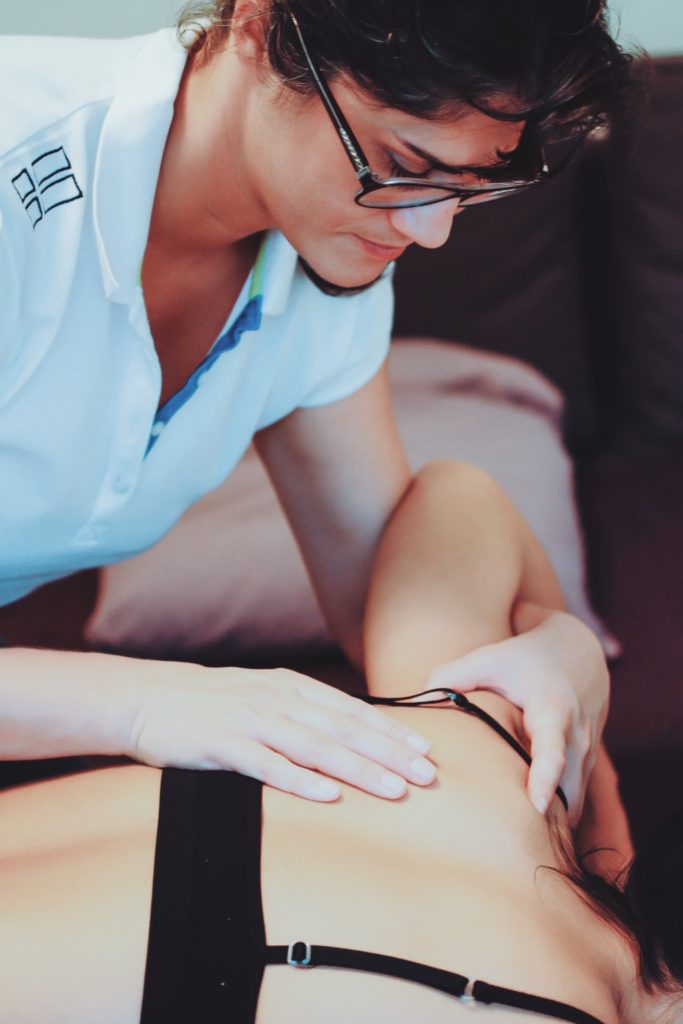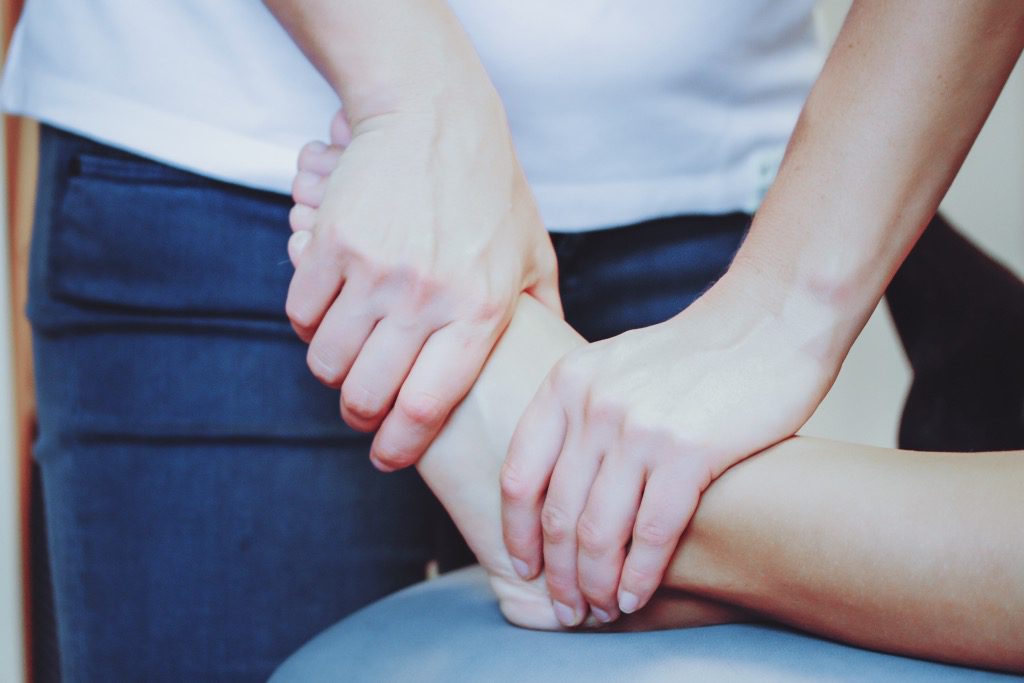What does an
Osteopath do?
An osteopath tries to find and treat the root cause of a problem, but can also treat symptoms if they are causing the pain. For instance, do I treat trigger points or tense muscles in headache patients if the muscles are the primary cause of pain. In addition to reducing pain I will examine other structures to find the cause of the muscle tension.
Many clients have asthma, IBS (irritable bowel syndrome), Crohn’s disease, arthritis and even diabetes as an underlying diagnosis. I also need to consider that these underlying conditions may be part of the problem. The in-depth anamnesis at the beginning of the treatment session is therefore important, as it gives me information on how to treat. Osteopaths treat more than you think.

My approach as Osteopath
Many times, I combine structural and functional treatment techniques, as it has proven to give the best effects in my clients. I mainly use my hands as a tool. And I am an intuitive therapist who listens to what is happening in the client’s body to find blocked areas. Getting a picture of the whole body can be important for treating a particular area. With my hands I feel the fluid circulation, status of vitality and change in the tissues during the treatment.
And it is probably my unique ability to listen with my hands that distinguishes me as an osteopath from any other manual therapist. The difference between professions is the philosophy and how one thinks about the body and how different body organs are connected. My primary goal is to restore the body’s balance and mobility to provide the body with the best condition to heal itself. In other words, I cannot restore a herniated disc, but I can create conditions in the tissues that reduce pain or other symptoms.
Case History and Experience
During the case history I mainly focus on physical obstacles, but in some cases I need to talk more about internal health to be able to help in the best way. In addition to musculoskeletal disorders, such as back pain, stiffness, pain in the neck, shoulders, pelvis, and hips, I also have many clients who suffer from headaches, migraines, and indigestion. In my clinic I offer ayurvedic health coaching to address these issues.
What techniques does
an osteopath use?
Manipulation of joints to restore normal mobility where the mobility is reduced
Mobilisation of joints and ligaments that may have an anti-inflammatory and pain reducing effect
Gentle soft tissue stretching, trigger point release and muscular energy techniques to relax the muscles and increase the mobility of the joints
Balanced ligamentous tension techniques
Myofascia release and lymphatic drainage techniques to improves fluid circulation and thereby reducing inflammation
Visceral osteopathy for constipation or diarrhoea, menstrual pain and infertility
Cranial osteopathy is used for stress, digestive problems, and anxiety problems
Neural manipulation to treat nerves and neural tissue

Your first treatment session – What to expect
Your first visit always begins with an anamnesis about your current ailments and your medical history, i.e., previous diagnoses, surgeries, and accidents. We also talk about lifestyle routines, sleep, and work ergonomics. Gut health and digestive problems may be important to know. The case history is followed by an examination that includes posture and movement analysis, as well as neurological or orthopaedic tests. In some cases, I take the patients’ blood pressure.
During a treatment
I observe your posture and your movements to identify any obvious lack of motion in the spine or other joints. Then I will examine you and sometimes I stay close to the body part where you experience symptoms, and sometimes I start my examination further away from the body part that is in pain. How I examine depends on the information I gathered during the anamnesis. Palpation of the different body parts is always necessary, to find out which structures may be involved. Depending on the problem, I may ask you to take off some of your clothes. It is a good idea to wear comfortable clothes, so that I can perform various passive movements with your arms or legs.
How long does an osteopathic treatment take?
The first treatment usually takes between 50 and 60 minutes, because I want to get a good picture of your health and your symptoms. A follow-up visit usually takes between 30 and 40 minutes and depends on the technique I use and how chronic your symptoms are. An osteopathic treatment includes different treatment modalities that I adapt to my clients’ individual needs. If you don’t want to be treated with a certain technique you can just let me know. I may even refer you to your doctor or a colleague for a follow-up session. I have a wide network of colleagues who may help you as well.
Conditions
Osteopathy can treat:
MUSCULOSKELETAL DISORDERS
An osteopath treats all types of pain – neuropathic, acute, and chronic. Many people pay me a visit because they want a treatment for stiffness, back pain, sciatica, or numbness and even pain caused by a herniated disc. Some people have pain in the hip or pelvis. A few people have pain in the tailbone. Some people experience numbness or tingling as well as loss of sensation in their arm, fingers or leg and feet.
TMJ PAIN & TINNITUS
Over the past years, I have had more and more clients who experience jaw or TMJ pain and even pain in the face that needs to be assessed before I can tell the root cause. There are many reasons for jaw or TMJ pain that even may be related to the face and neck structures. More people are seeking help with tinnitus, but unfortunately, I do not know of any treatment that can reverse tinnitus completely. So far, I have only been able to reduce symptoms in some of my clients. Stress management is important to reduce the noise, but you might need to visit your dentist to rule out dental issues.
GUT DISORDERS & IBS
Osteopathic treatment can dissolve tension in the abdomen that often comes with internal and external stress on body and mind, sedative lifestyle. Digestive problems can occur because you may eat food that your body does not tolerate and is allergic to. Symptoms of IBS, Crohn’s disease, as well as heartburn and a painful or swollen abdomen can be significantly reduced in an osteopathic treatment. I usually address the importance of healthy routines and stress management in the case history or in one of the health counselling packages I offer. Certain medications cause and maintain gut disorders.
HEADACHE & MIGRAINE
Headaches, tension headaches or migraines, are conditions that I treat daily in my clinic. I often address it by treating posture, talking about stress management, work ergonomics or food intolerances. Migraines and headaches can also occur due to blood sugar imbalances or trauma (physical or emotional). Very often I need two to three treatments to reduce or resolve headaches. It is a possibility for you to rule out vision or eyes problems as well as blood sugar imbalances before coming to me.
POSTNATAL & PREGNANCY
Postnatal and pregnancy problems, especially in the neck, chest, and pelvis, are very common and can be easily restored. Osteopathy is a gentle treatment method during pregnancy to prevent and treat pain, aches and muscle fatigue that occurs due to the growing stomach or malposition during breastfeeding. Joint loosening can occur when the stomach grows and are treatable. Acupuncture and physiotherapy can also be good for joint loosening during pregnancy.
BREATHING DIFFICULTIES
Osteopathy can help to reduce symptoms of asthma or other respiratory problems. Chronic conditions, however, need regular follow-ups over time. Minor injuries or pains that occurred only recently may just need one treatment.
MENSTRUAL DISORDERS
Menstrual disorders and PMS often originate in a hormonal imbalance of sex hormones but can occur if the pelvis is not aligned properly. Pressure from the abdomen or other bodily abnormalities can lead to menstrual pain and misalignment of pelvic structures.

What is
Osteopathy?
Osteopathy aims to improve function of musculoskeletal and visceral structures. Therefore, it provides better conditions for flexibility, body fluid dynamics, stamina, and strength. It even helps to reduce risk of injury. The treatment techniques can help you to heal faster and reduce recovery time from injury.
In general osteopathy is used as a preventative measure to maintain mobility and stability of the body’s joints. Moreover, it maintains the body’s circulatory, nervous, and lymphatic system functions. A treatment supports your overall mental and physical balance. Combined with the right dietary and exercise approach it enhances your wellbeing and enables you to take responsibility over your own health. Acute, sub-acute and chronic conditions as well as injuries can be treated.
History
It was Dr. Andrew Taylor Still who established the practice of Osteopathy in the late 1800s in the United States without the use of drugs. He aimed using manual hands-on techniques to improve circulation and correct altered biomechanics. Since then, osteopathy has been recognised in many countries, but especially in North America, England, Switzerland, France, Australia, Norway, and Finland.
a holistic approach
Osteopathy is a drug-free and non-invasive manual treatment that focuses on the body as a whole. We are in fact body, mind, and spirit. This is mainly done by treating and strengthening the musculoskeletal framework. The framework includes the fascia, joints, muscles, and spine, as well as internal organs. Its aim is to balance the body’s nervous, circulatory, and lymphatic systems.
It’s a unique holistic approach to health care meaning that osteopaths do not just concentrate on treating symptomatic areas. They rather examine and treat other related parts of the body that might have caused the symptoms.
osteopathic principles
The principles of osteopathy are very simple. All parts of the body function as a unit and thereby in an integrated manner. If one part of the body is restricted, then the rest of the body must adapt and compensate, eventually leading to inflammation, pain, stiffness, and other health conditions.
Osteopaths respect the body’s natural ability of self-regulation that keeps itself in balance. When the body is free of restrictions in movement, osteopathic treatment assists the body with different techniques to reduce pain and stress. It certainly provides greater mobility with the opportunity for healing.
Different styles of osteopathy
As in all professions, there are different schools with different philosophies and teachers. Therefore, osteopaths treat their clients differently despite the same principles.
In classical osteopathy, where you often get a whole-body treatment, therapy affects all the tissues and organs in the body. Then there are minimalists who use only a few manipulations to get a good effect.
Some osteopaths work only with craniosacral osteopathy, which was explored in the 20th century by Dr. William G. Sutherland. It’s a soft and comfortable treatment modality. Visceral Manipulation (VM) is another style, developed by the French osteopath and physiotherapist Jean-Pierre Barral. VM assists functional and structural imbalances throughout the body. Above all it treats the dynamics of motion and suspension in the body’s organs, membranes, fascia, and ligaments.
Both craniosacral and visceral osteopathy are also referred to as “functional” as they increase proprioceptive communication within the body. Moreover, they are subtle techniques that requires good palpation skills of the practitioner.
Osteopathy in sweden
I am a member of the Swedish Osteopathic Association (SOF). SOF is a nationwide professional association for osteopaths that today has over 380 members. SOF members must have undergone training that meets European standards and is the only guarantee in Sweden that an osteopath has an adequate training.
The broad application of osteopathy and soft methods are suitable for children, adults, and the elderly. However, an osteopath in Sweden is not allowed to treat children under the age of 8 according to the law. In the Nordic countries, Sweden is the only country where osteopaths are not integrated in the healthcare system. And, in Sweden it takes a 4-year university education to become an osteopath.

Prices
First visit
A first visit can take up to 50 to 60 minutes. You will get a treatment after taking your case history.
SEK 895
Follow up
Follow-up visits can take between 30 to 40 minutes.
SEK 895
Buy 4, get 5 - save 25%
The package includes 5 treatments for the price of 4. Valid for 5 months fr people who need regular help and with chronic conditions.
SEK 3.580 / 5 treatments
Osteopathy 45 min & trigger point treatment 30 min
If you like me to examine and treat your body in a holistic way, but also need a muscle treatment.
SEK 1.390
